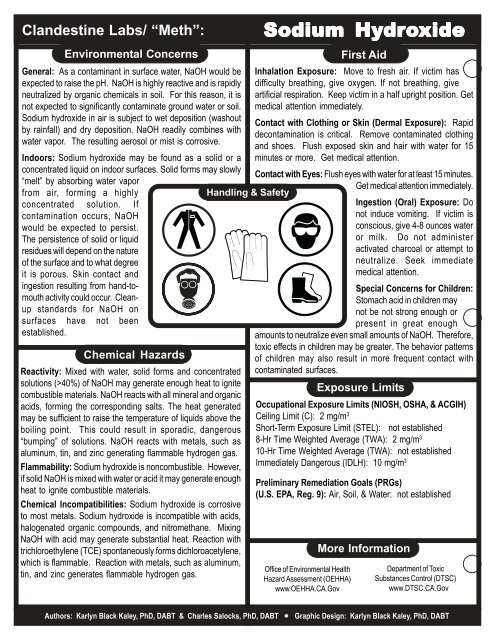Clan Labs Meth Sodium Hydroxide FS 10'29'03.pmd - OEHHA
Clan Labs Meth Sodium Hydroxide FS 10'29'03.pmd - OEHHA
Clan Labs Meth Sodium Hydroxide FS 10'29'03.pmd - OEHHA
Create successful ePaper yourself
Turn your PDF publications into a flip-book with our unique Google optimized e-Paper software.
<strong>Clan</strong>destine <strong>Labs</strong>/ “<strong>Meth</strong>”: <strong>Sodium</strong> <strong>Sodium</strong> Hy Hydr Hy dr droxide dr xide<br />
Environmental Concerns<br />
General: As a contaminant in surface water, NaOH would be<br />
expected to raise the pH. NaOH is highly reactive and is rapidly<br />
neutralized by organic chemicals in soil. For this reason, it is<br />
not expected to significantly contaminate ground water or soil.<br />
<strong>Sodium</strong> hydroxide in air is subject to wet deposition (washout<br />
by rainfall) and dry deposition. NaOH readily combines with<br />
water vapor. The resulting aerosol or mist is corrosive.<br />
Indoors: <strong>Sodium</strong> hydroxide may be found as a solid or a<br />
concentrated liquid on indoor surfaces. Solid forms may slowly<br />
“melt” by absorbing water vapor<br />
from air, forming a highly<br />
concentrated solution. If<br />
contamination occurs, NaOH<br />
would be expected to persist.<br />
The persistence of solid or liquid<br />
residues will depend on the nature<br />
of the surface and to what degree<br />
it is porous. Skin contact and<br />
ingestion resulting from hand-tomouth<br />
activity could occur. Cleanup<br />
standards for NaOH on<br />
surfaces have not been<br />
established.<br />
Chemical Hazards<br />
Reactivity: Mixed with water, solid forms and concentrated<br />
solutions (>40%) of NaOH may generate enough heat to ignite<br />
combustible materials. NaOH reacts with all mineral and organic<br />
acids, forming the corresponding salts. The heat generated<br />
may be sufficient to raise the temperature of liquids above the<br />
boiling point. This could result in sporadic, dangerous<br />
“bumping” of solutions. NaOH reacts with metals, such as<br />
aluminum, tin, and zinc generating flammable hydrogen gas.<br />
Flammability: <strong>Sodium</strong> hydroxide is noncombustible. However,<br />
if solid NaOH is mixed with water or acid it may generate enough<br />
heat to ignite combustible materials.<br />
Chemical Incompatibilities: <strong>Sodium</strong> hydroxide is corrosive<br />
to most metals. <strong>Sodium</strong> hydroxide is incompatible with acids,<br />
halogenated organic compounds, and nitromethane. Mixing<br />
NaOH with acid may generate substantial heat. Reaction with<br />
trichloroethylene (TCE) spontaneously forms dichloroacetylene,<br />
which is flammable. Reaction with metals, such as aluminum,<br />
tin, and zinc generates flammable hydrogen gas.<br />
Handling & Safety<br />
First Aid<br />
NH 4<br />
Inhalation Exposure: Move to fresh air. If victim has<br />
difficulty breathing, give oxygen. If not breathing, give<br />
artificial respiration. Keep victim in a half upright position. Get<br />
medical attention immediately.<br />
Contact with Clothing or Skin (Dermal Exposure): Rapid<br />
decontamination is critical. Remove contaminated clothing<br />
and shoes. Flush exposed skin and hair with water for 15<br />
minutes or more. Get medical attention.<br />
Contact with Eyes: Flush eyes with water for at least 15 minutes.<br />
Get medical attention immediately.<br />
Ingestion (Oral) Exposure: Do<br />
not induce vomiting. If victim is<br />
conscious, give 4-8 ounces water<br />
or milk. Do not administer<br />
activated charcoal or attempt to<br />
neutralize. Seek immediate<br />
medical attention.<br />
Special Concerns for Children:<br />
Stomach acid in children may<br />
not be not strong enough or<br />
present in great enough<br />
amounts to neutralize even small amounts of NaOH. Therefore,<br />
toxic effects in children may be greater. The behavior patterns<br />
of children may also result in more frequent contact with<br />
contaminated surfaces.<br />
Exposure Limits<br />
Occupational Exposure Limits (NIOSH, OSHA, & ACGIH)<br />
Ceiling Limit (C): 2 mg/m 3<br />
Short-Term Exposure Limit (STEL): not established<br />
8-Hr Time Weighted Average (TWA): 2 mg/m 3<br />
10-Hr Time Weighted Average (TWA): not established<br />
Immediately Dangerous (IDLH): 10 mg/m 3<br />
Preliminary Remediation Goals (PRGs)<br />
(U.S. EPA, Reg. 9): Air, Soil, & Water: not established<br />
Office of Environmental Health<br />
Hazard Assessment (<strong>OEHHA</strong>)<br />
www.<strong>OEHHA</strong>.CA.Gov<br />
More Information<br />
Department of Toxic<br />
Substances Control (DTSC)<br />
www.DTSC.CA.Gov<br />
Authors: Karlyn Black Kaley, PhD, DABT & Charles Salocks, PhD, DABT • Graphic Design: Karlyn Black Kaley, PhD, DABT















